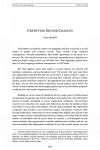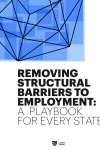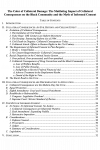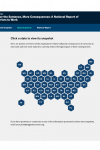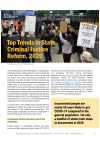Resources
"Search Results" - 163 item(s) found.
-
Cara Suvall, Cardozo Law Review
(March 2021)The premise of this article is that policymakers around the country are grappling with how to provide a second chance to people with criminal records, which the author asserts, create collateral consequences—invisible punishments that inhibit opportunity in all facets of a person’s life. The article highlights that, over the past ... -
The Sentencing Project
(March 2021)As the brief points out, 5.2 million people in the United States are currently denied access to the vote because of a felony conviction. The number of people disenfranchised has grown, from 1.2 million in 1976, as a product of mass incarceration and supervision. Of people denied the vote, one in four ... -
The Council of State Governments Justice Center
(February 2021)Many state and federal regulations limit or prohibit people with criminal records from accessing employment, education, housing, and more. Some states have taken action to understand and remove these restrictions, known as collateral consequences, which have a particularly devastating effect on employment opportunities. The national playbook identifies best practice goals and ... -
Trevor Shoels, Texas Tech University School of Law
(February 2021)This article examines the extent to which certain collateral consequences almost exclusively affect Black people, as the author compares such consequences to Jim Crow laws. Similar to Jim Crow laws, the author asserts, these collateral consequences almost exclusively prohibit individuals who are Black with a criminal record from public housing, ... -
The Public Defender Service for the District of Columbia
(January 2021)This publication is designed to empower and equip people affected by the D.C. criminal justice system with necessary information to successfully navigate reentry and reintegration. It is intended for use by people who are currently incarcerated or recently released, people living in the community with a D.C. criminal record, or ... -
The Council of State Governments Justice Center
(January 2021)A complex web of local, state, and federal statutes and regulations—known as collateral consequences of conviction—can make it all but impossible for some people with criminal records to truly rebuild their lives. These state snapshots from The Council of State Governments Justice Center present an overview of the nearly 30,000 state and federal ... -
Collateral Consequences Resource Center
(January 2021)In 2020, 32 states, the District of Columbia, and the federal government enacted 106 legislative bills, approved 5 ballot initiatives, and issued 4 executive orders to restore rights and opportunities to people with a criminal record. -
Nicole D. Porter, The Sentencing Project
(January 2021)According to this brief, the United States is the world leader in incarceration and keeps nearly 7 million persons under correctional control. More than 2 million are in prison or jail, and 4.6 million are under community surveillance on probation or parole. At least 19 million persons are living with ...
